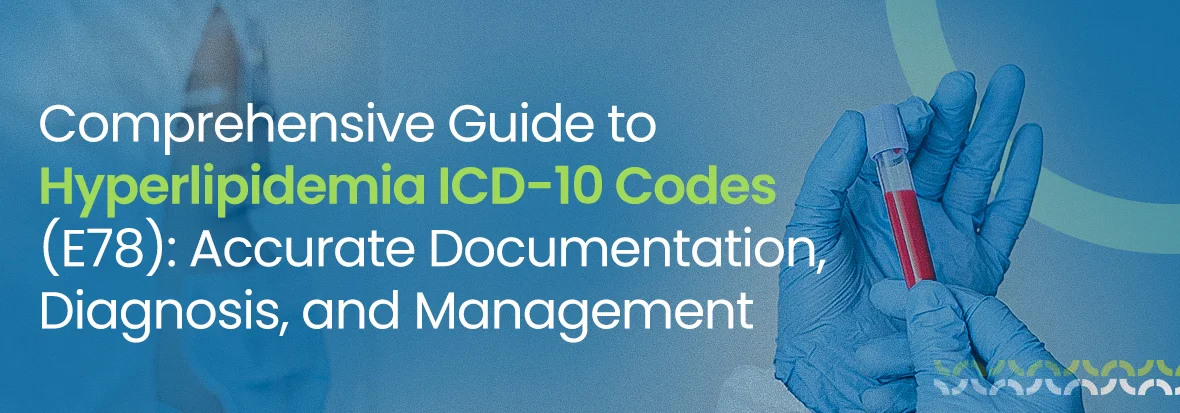Hyperlipidemia is under ICD-10 code E78 which includes all disorders of lipid metabolism, including hyperlipidemia ICD 10. ICD-10 coding is important for diagnosis, treatment planning and insurance reimbursement. Optimize hyperlipidemia reimbursements with our medical billing services for error-free claims. This article will break down the codes within the E78 category so healthcare providers can document hyperlipidemia correctly and better care for their patients.
Quick Facts
- Hyperlipidemia with elevated blood lipids increases risk of cardiovascular disease so monitoring and management is key.
- ICD-10 codes for hyperlipidemia, especially E78, classify lipid metabolism disorders for diagnosis and treatment so better patient care.
- Management of hyperlipidemia is a combination of lifestyle changes and pharmacotherapy with healthcare providers playing a key role in monitoring and coordinating patient care.
What is Hyperlipidemia
Hyperlipidemia means high levels of lipids in the blood. This includes high cholesterol and triglycerides. These abnormal lipid levels are called dyslipidemia and are significant because they increased risk of cardiovascular disease such as heart attacks and strokes. High blood fats or lipids disrupts normal cholesterol metabolism and accumulates in the blood stream.
The types of lipids that can be measured in the blood are total cholesterol and triglycerides. These are important for cardiovascular risk assessment. Elevated lipid levels especially low-density lipoproteins (LDL) and high-density lipoprotein (HDL) means there is an imbalance in cholesterol and triglycerides that needs medical attention. This imbalance can lead to lipoprotein metabolism disorders and overall health problems.
Abnormal lipid levels increase risk of cardiovascular disease so monitoring and management of cholesterol is key. Management involves understanding the different types of lipids and their effect on cholesterol and triglycerides. Keeping lipid levels optimal reduces risk of heart disease and other related conditions. For healthcare providers and clinics, accurate documentation and coding supported by professional Cardiology Billing Services can help ensure that treatment and management of hyperlipidemia are properly reimbursed and compliant with regulations.
ICD-10 Codes for Hyperlipidemia
ICD-10 categorizes hyperlipidemia under E78 which includes different codes for different lipid metabolism disorders. These codes are important for documenting diagnoses, treatment plans and insurance reimbursement. ICD-10 helps healthcare providers to classify and manage hyperlipidemia based on the type and severity of the condition.
Knowing hyperlipidemia is important to choose the right ICD-10 codes. Classification of hyperlipidemia under ICD-10, specifically under ‘Other Disorders of Lipid Metabolism’ (E78) ensures accurate diagnosis and treatment. Accurate coding is not only for clinical practice but also for better patient care and resource allocation.
Hyperlipidemia is classified into different types based on lipid levels and corresponding ICD-10 codes. Knowing these ICD-10 codes is important for healthcare providers to ensure accurate diagnosis and treatment.
The following sections will go into the specific codes for pure hypercholesterolemia, pure hyperglyceridemia and mixed hyperlipidemia.
E78.0 – Pure Hypercholesterolemia
E78.0 code is for pure hypercholesterolemia which means elevated cholesterol levels. This condition is characterized by high LDL cholesterol and increases risk of cardiovascular disease. E78.0 is for conditions like Fredrickson’s type IIa hyperlipoproteinemia so precise coding is important to ensure accurate diagnosis and management.
E78.0 requires precise coding for patients with elevated cholesterol levels. Healthcare providers must ensure the diagnosis code is accurate so treatment plans and reimbursement can be done accordingly.
E78.1 is the ICD-10 code for hypertriglyceridemia. This code is for pure hyperglyceridemia which means raised triglyceride levels without other lipid disorders. Accurate identification of this condition is crucial for targeted treatment and management.
E78.1 – Pure Hyperglyceridemia
E78.1 is for elevated triglycerides without other lipid disorders. Accurate coding so patients can receive the right care and healthcare providers can track and manage pure hyperglyceridemia cases.
E78.2 – Mixed Hyperlipidemia
Mixed hyperlipidemia is characterized by elevated levels of both cholesterol and triglycerides in the blood. This condition has high LDL cholesterol and triglycerides and increases risk of atherosclerosis and heart disease. E78.2 is for mixed hyperlipidemia so comprehensive management is needed to mitigate cardiovascular risk.
Mixed hyperlipidemia is a big risk for atherosclerosis and heart disease. Unhealthy lifestyle habits like poor diet and lack of exercise are contributing factors to this condition. Accurate coding of mixed hyperlipidemia is important to prevent severe health problems.
Management of mixed hyperlipidemia requires lifestyle modifications and pharmacotherapy to control lipid levels. E78.2 coding ensures patients get care tailored to their specific lipid disorders.
Other ICD-10 Codes for Lipid Metabolism Disorders

Besides the ICD-10 codes for hyperlipidemia, there are other codes for lipid metabolism disorders. These codes help healthcare providers to classify and document conditions accurately so treatment plans and resources can be allocated accordingly.
The following sections will go into these codes.
E78.5 – Hyperlipidemia, Unspecified
E78.5 is the ICD-10 code for hyperlipidemia not elsewhere classified. This is a broader term for hyperlipidemia that doesn’t fit into any other detail category. This allows healthcare providers to classify and document hyperlipidemia cases when specific type is not identified so treatment plans can be done accordingly.
E78.5 helps healthcare providers to track the overall prevalence of hyperlipidemia among patients. Accurate coding of unspecified hyperlipidemia enhances patient care and resource allocation.
E78.6 – Lipoprotein Deficiency
E78.6 is the ICD-10 code for lipoprotein deficiency. Lipoprotein deficiency can cause various metabolic disorders which affects cholesterol metabolism and overall health. Accurate coding of lipoprotein deficiency is important for management and treatment.
E78.6 specifically identifies conditions with lipoprotein deficiency which is important in lipid transport and metabolism. Accurate coding ensures proper patient care and tracking and management of these conditions by healthcare providers.
E78.9 – Disorder of Lipoprotein Metabolism, Unspecified
E78.9 is a billable code for unspecified disorder of lipoprotein metabolism.
Why ICD-10 Coding Matters
ICD-10 codes are used for documentation of diagnoses, treatment plans and insurance reimbursement. ICD-10 coding for hyperlipidemia is important for accurate diagnosis and treatment planning. Understanding the ICD-10 codes for hyperlipidemia helps to differentiate between various lipid disorders for better clinical outcomes.
Inaccurate coding can lead to mismanagement and worsening of a patient’s condition. Detailed documentation including medical records, physician notes, lab results and clinical assessment is important for accurate coding. This documentation affects reimbursement and communication among medical professionals.
Coding specialists work with healthcare providers to clarify medical record details so accurate ICD-10 coding can be done. Following coding guidelines and providing detailed documentation is important in choosing the right ICD-10 code to track public health trends and treatment outcomes.
Symptoms and Risk Factors of Hyperlipidemia
Hyperlipidemia is often asymptomatic and is called a ‘silent’ condition. Patients with mixed hyperlipidemia may not show symptoms at first but can develop symptoms like chest pain or fatigue later. Cholesterol screening is recommended for individuals 20 and above to check and manage cholesterol levels.
Diet, inactivity and genetic predisposition increases the risk of developing dyslipidemia diabetes type. Common risk factors are family history of heart disease, obesity, diabetes and sedentary lifestyle.
Pure hypercholesterolemia is high LDL cholesterol which increases the risk of cardiovascular disease. High triglyceride levels can be due to diet and genetics and needs to be monitored and managed.
Management and Treatment of Hyperlipidemia
Management of hyperlipidemia often requires big lifestyle changes and medication. A heart healthy diet is important to lower cholesterol. This means reducing saturated and trans fats and increasing fruits, vegetables and whole grains. These dietary changes can balance cholesterol metabolism and lower lipid levels.
Physical activity is another important part of managing hyperlipidemia. At least 150 minutes of moderate aerobic exercise weekly can lower cholesterol and overall cardiovascular health. Quitting smoking can increase HDL cholesterol and lower triglycerides and reduce the risk of coronary heart disease. Weight loss even 5-10% of body weight can lower cholesterol and heart disease risk factors.
Lowering low-density lipoprotein (LDL) cholesterol is important in managing hyperlipidemia and preventing cardiovascular events. For patients with mixed hyperlipidemia, lifestyle modification is often accompanied by pharmacotherapy to control lipid levels. Medications like statins, fibrates and omega-3 fatty acids are commonly prescribed to manage bile acid and cholesterol levels to get comprehensive treatment.
Spend less time on billing, more on patient care.
Role of Healthcare Providers in Hyperlipidemia
Healthcare providers are key in managing hyperlipidemia from diagnosis to treatment. ICD-10 codes helps in accurate diagnosis and optimize patient care by categorizing different types of hyperlipidemia. Accurate coding facilitates communication among healthcare providers to coordinate patient care and ensure patients get the best treatment.
Accurate coding affects reimbursement process and the financial health of the healthcare facility. Worried about coding accuracy? Get a medical billing consultation to identify gaps. Coding specialists makes sure the documentation is sufficient to assign ICD-10 codes, hence the importance of detailed medical records and collaboration among healthcare providers.
Together healthcare providers can manage hyperlipidemia better and improve patient outcomes.
Conclusion
Hyperlipidemia with elevated lipid levels in the blood is a big risk for cardiovascular disease. Understanding the different types of hyperlipidemia and their ICD-10 codes is important for accurate diagnosis and management. Healthcare providers must code accurately to get the right treatment plan and reimbursement and optimize patient care.
Ongoing management and awareness of hyperlipidemia is important to prevent severe health issues. By having a heart healthy lifestyle, regular physical activity and working with healthcare providers, individuals can lower their cholesterol and reduce cardiovascular disease risk. Accurate ICD-10 coding is part of the process to get comprehensive and effective care.

